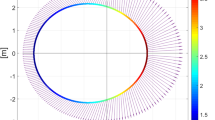Abstract
We investigate the utility of a constellation of four satellites in heliocentric orbit, equipped with accurate means to measure intersatellite ranges, round-trip times and phases of signals coherently retransmitted between members of the constellation. Our goal is to reconstruct the measured trace of the gravitational gradient tensor as accurately as possible. Intersatellite ranges alone are not sufficient for its determination, as they do not account for any rotation of the satellite constellation, which introduces fictitious forces and accelerations. However, measuring signal round-trip time differences along clockwise and counterclockwise signal paths in a Sagnac-type measurement among the satellites supplies the necessary observables to estimate, and subtract, the effects of rotation. Utilizing, in addition, the approximate distance and direction from the Sun, it is possible to approach an accuracy of \(10^{-24}~{\mathrm{s}}^{-2}\) for a constellation with typical intersatellite distances of 1000 km in an orbit with a 1 astronomical unit semi-major axis. This is deemed sufficient to detect the presence of a galileonic modification of the solar gravitational field.





Similar content being viewed by others
Code Availability
The simulation code described in this manuscript is published at https://github.com/vttoth/TETRA.
Notes
This form follows directly from the right-hand side of the alternate form of Einstein’s field equation in the Newtonian approximation, specifically the term \(T_{00}-\tfrac{1}{2}g_{00}T\) with \(T_{\mu \nu}=\operatorname {diag}(c^{2}\rho ,-p,-p,-p)\) for an isotropic perfect fluid.
References
Curtright, T.L., Fairlie, D.B., Alshal, H.: A Galileon primer (2012). arXiv:1212.6972 [hep-th]
Kepler, J., Ptolemaeus, C., Fludd, R.: Harmonices Mvndi Libri (1619)
Nicolis, A., Rattazzi, R., Trincherini, E.: Galileon as a local modification of gravity. Phys. Rev. D 79(6), 064036 (2009). https://doi.org/10.1103/PhysRevD.79.064036. arXiv:0811.2197 [hep-th]
Poisson, S.D.: Sur la théorie du magnétisme en mouvement. Mémoires l’académie des sciences VI, 441–570 (1823)
Raphson, J.: Analysis Aequationum Universalis, 2nd edn. Iohannem Taylor, London (1697)
Rodrigues: Des lois géométriques qui régissent les déplacements d’un système solide dans l’espace, et de la variation des coordonnées provenant de ces déplacements considérés indépendamment des causes qui peuvent les produire. Journal de Mathématiques Pures et Appliquées, 380–440 (1840)
Sagnac, G.: L’éther lumineux démontré par l’effet du vent relatif d’éther dans un interféromètre en rotation uniforme. Comptes Rendus 157, 708–710 (1913a)
Sagnac, G.: Sur la preuve de la réalité de l’éther lumineux par l’expérience de l’interférographe tournant. Comptes Rendus 157, 1410–1413 (1913b)
Seidel, L.: Über die Berechnung der wahrscheinlichsten Werthe solcher Unbeckannten zwischen welchen Bedingungs-Gelichungen bestehen. Astron. Nachr. 84(13), 193 (1874). https://doi.org/10.1002/asna.18740841302
Yu, N., Chiow, S.-w., Gleyzes, J., Bull, P., Dore, O., Rhodes, J., Jewell, J., Huff, E., Muller, H.: Direct probe of dark energy interactions with a Solar System laboratory (2018). https://ntrs.nasa.gov/citations/20190002500
Acknowledgements
VTT thanks Slava Turyshev for discussions and acknowledges the generous support of David H. Silver, Plamen Vasilev and other Patreon patrons.
Funding
The authors declare that no funds, grants, or other support were received during the preparation of this manuscript. The authors have no relevant financial or non-financial interests to disclose. The authors consent to publication of this manuscript.
Author information
Authors and Affiliations
Contributions
VTT wrote the entire manuscript and developed the software used for analysis.
Corresponding author
Ethics declarations
Competing interests
The authors declare no competing interests.
Additional information
Publisher’s Note
Springer Nature remains neutral with regard to jurisdictional claims in published maps and institutional affiliations.
Rights and permissions
Springer Nature or its licensor (e.g. a society or other partner) holds exclusive rights to this article under a publishing agreement with the author(s) or other rightsholder(s); author self-archiving of the accepted manuscript version of this article is solely governed by the terms of such publishing agreement and applicable law.
About this article
Cite this article
Toth, V.T. Gravitational anomaly detection using a satellite constellation: analysis and simulation. Astrophys Space Sci 368, 92 (2023). https://doi.org/10.1007/s10509-023-04248-5
Received:
Accepted:
Published:
DOI: https://doi.org/10.1007/s10509-023-04248-5




